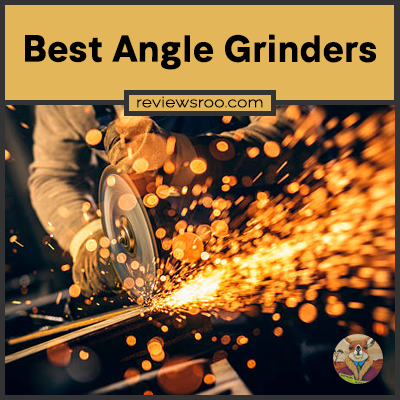Best Angle Grinders
Grinders are essential tools for any workshop. They’re used to cut, shape and sharpen materials with ease. But how do you know which one is best for your project? We’ve done the research and found the best angle grinders on the market.

Whether you’re a professional or a hobbyist, you’ll find an angle grinder that suits your needs. From powerful corded models to lightweight cordless options, we’ve got it all covered. With our guide, you’ll be able to pick an angle grinder that’s perfect for your project.
We’ve analyzed dozens of grinders and narrowed down our list to the top five models on the market today. Our reviews cover everything from performance to safety features so you can make an informed decision when picking out your new tool. Read on to find out which angle grinder is right for you!
What Is An Angle Grinder?
An angle grinder is an all-purpose tool that can be used for cutting, grinding and polishing. It’s a powerful hand-held tool with a spinning disc that can rapidly cut through materials like metal and stone. It’s a must-have in any DIYer’s toolbox.
Its versatile design makes it suitable for both home and commercial use. The grinder has a motorized head which rotates at high speeds, allowing the user to make precise cuts and grinds. Its ergonomic design also allows for easier handling, making it less tiring when working with heavier materials. Additionally, its range of attachments makes it useful for different tasks such as sanding, buffing or even polishing edges.
Advantages Of Angle Grinders
Angle grinders are like power tools on steroids, providing immense convenience and versatility. They’re the perfect tool for any handyman or DIYer, delivering power and precision with a single spin of the wheel. But what makes angle grinders so great? Let’s explore the advantages.
First off, angle grinders boast impressive maneuverability. Their small wheel size and lightweight design make them easy to move around tight spaces, allowing you to get into those hard-to-reach places without any hassle. Plus, they come with adjustable guards that allow you to change direction quickly and safely – ideal for detailed projects that require intricate cutting or grinding.
Moreover, these tools provide plenty of power for quick work. Not only can they cut through metal with ease; their high speed also makes short work of sharpening blades and shaping materials in no time at all. So if you need a job done fast, an angle grinder is your go-to tool – it’ll have your project looking professional in no time! With all these benefits combined, it’s no wonder why angle grinders are a must-have item in any toolbox.
Next up: different types of angle grinders and how to choose the right one for your needs.
Different Types Of Angle Grinders
Angle grinders are like a Swiss Army Knife of tools – they can be used for a variety of applications. There are quite a few types available, each having their own strengths and weaknesses. From cordless to handheld models, there’s something for everyone’s needs.
The first type is the corded angle grinder, which is great for precise, detailed work like grinding and cutting hard materials. They’re also very powerful and can handle tough tasks with ease. The downside is that you need to be near an outlet when using them, and they tend to be on the heavier side.
The next type is the cordless angle grinder, which offers more portability than their corded counterparts. They’re lightweight and great for jobs where you need to move around a lot. The tradeoff is that they don’t have as much power as corded ones do.
Finally, there are handheld versions of angle grinders which offer the convenience of being able to work in tight spaces without needing any cords or outlets at all! They’re perfect for small DIY projects but lack the power of larger models so they may not be suitable for bigger tasks.
When it comes to finding the right tool for your job, it pays off to know your options so you can pick one that best suits your needs. With this knowledge in hand, you’ll be ready to find the best angle grinder brands that will get the job done right.
Best Angle Grinder Brands
When it comes to shopping for the best angle grinder, brand loyalty is an important factor. A powerful tool like this can definitely make or break a project, so you want to be sure you have one that’s reliable and backed by a solid warranty. Consider the following top brands when selecting your grinder: Makita, Dewalt, Bosch, Metabo, and Milwaukee.
These companies have earned their reputation for producing quality tools with durability and performance in mind. Makita has been in business since 1915 and is known for its long-lasting motors and ergonomic design. Dewalt is renowned for its cordless angle grinders which offer more mobility than their corded counterparts.
Bosch offers a range of models that are designed to tackle heavy-duty projects while still being lightweight enough to maneuver around tight corners easily. Metabo has a range of robust yet versatile tools that are perfect for heavy-duty projects such as grinding concrete or stone surfaces. Finally Milwaukee is praised for its range of powerful cordless grinders that deliver outstanding power in even the toughest jobs.
Each brand offers something unique so take your time researching before making a purchase decision.
Features To Consider When Buying An Angle Grinder
Angle grinders are the most essential tools for any handyman. They’re a must-have for anyone who loves to take on DIY projects, and they can tackle almost any task you throw at them. With so much riding on an angle grinder, it’s important to get the right one for your needs. Here are some features to consider when buying an angle grinder:
- Power: Look for an angle grinder that offers plenty of power – anything from 750 watts to 2200 watts should be adequate.
- Size: Angle grinders come in a variety of sizes, from 4 inches up to 9 inches or more. Choose the size that suits your needs best.
- Durability: Quality is key when it comes to angle grinders. Make sure you choose one made from durable materials like aluminum or steel so it will last for years to come.
When picking out an angle grinder, make sure you get one with all the features you need and that fits your budget. That way, you can be sure that your purchase will serve you well now and in the future. Now let’s move on to safety precautions when using an angle grinder…
Safety Precautions When Using An Angle Grinder
Using an angle grinder can be a daunting task. It is a tool that requires utmost respect, as it can be as dangerous as it is useful. Knowing the proper safety precautions to take when using this tool will help you make the most of its powerful capabilities while keeping yourself and others safe.
First and foremost, always wear protective gear when operating an angle grinder. This includes goggles, gloves, long pants, steel-toed boots, and of course hearing protection. Additionally, here are some key safety points to keep in mind:
- Don’t use damaged discs or wheels
- Make sure the disc is firmly fitted on the spindle
- Keep your hands away from the moving parts
- Never leave the grinder running unattended.
These are just a few of the steps that should be taken to ensure everyone’s safety when using an angle grinder – following them will give you peace of mind while allowing you to get the job done right.
How To Choose The Right Angle Grinder For Your Needs
Angle grinders are incredibly useful tools, with over 100 million sold worldwide each year. When it comes to choosing the right one for your needs, there are a few key considerations.
First, you’ll want to think about the size of the disc – 4-5 inches is generally best for DIY tasks. Next up is power – typically measured in amps – and this will determine how quickly and efficiently your grinder can work. Lastly, you’ll need to decide whether to buy corded or cordless; corded models tend to be more powerful but require an outlet nearby.
When selecting an angle grinder:
- Look at the sizes of disc available, with 4-5 inch discs being ideal for most DIY projects
- Consider the power rating (measured in amps); and * Decide between a corded or cordless model.
It’s also important to pay attention to comfort features like ergonomic handles and vibration dampening technology to ensure safe and comfortable use. With these considerations in mind, you should be able to find an angle grinder that suits your project needs precisely without breaking the bank. With the right tool selected, you can tackle any job with confidence. Moving ahead, common uses of angle grinders include cutting tile and stone, grinding metal and mortar removal.
Common Uses Of Angle Grinders
Angle grinders are versatile tools that can be used for a variety of applications. They’re great for sharpening, grinding, cutting and polishing. But with so many uses, it’s important to understand the right tool for the job. In this section, we’ll discuss some of the most common uses of angle grinders.
The most common use is for grinding, which involves using a grinding wheel to achieve a smooth, even finish on metal surfaces. Angle grinders are also great for cutting through hard materials such as bricks and concrete. The grinder can be used to create straight edges on a surface or make angled cuts in more complex shapes. Polishing is another popular use as angle grinders make it easy to buff out scratches and remove rust from metal surfaces. Finally, angle grinders are often used in welding projects to clean up rough edges around welds before they’re painted or coated.
With all these uses, an angle grinder can be an invaluable tool in any workshop or job site.
Tips For Using An Angle Grinder
Angle grinders are versatile tools that require practice and caution to use. These tips can help you get the most out of yours:
Wear safety gear. Eye protection, gloves, and other protective equipment should be worn when using your angle grinder. Make sure to check the manual for the correct type of protective gear for your model.
Secure your workpiece. Your workpiece should be firmly clamped or held down to ensure that it won’t move as you’re working on it. It’s also important to keep your hands away from the moving parts of the grinder so that they don’t get injured in case anything slips or falls.
Practice makes perfect. Take some time to practice using your angle grinder before tackling bigger projects, so that you can get used to how it operates and how much power is needed for different tasks.
Adjust the speed accordingly. Depending on what kind of material you’re working with, you may need to adjust the speed of your angle grinder accordingly so that it doesn’t overheat or damage the material you’re cutting or grinding.
Be mindful of sparks and debris. Angle grinders produce a lot of sparks and debris, so make sure that there’s nothing flammable around your work area, such as paper or fabric, and wear additional protective clothing if needed.
Using an angle grinder correctly requires skill and patience; take the time to get familiar with yours before starting any project. With these tips in mind, you’ll be prepared for whatever comes up next when it comes time for maintenance and care for angle grinders.
Maintenance And Care For Angle Grinders
Using an angle grinder can be a daunting task if not taken seriously. It’s like having a wild beast in your hands – it needs to be tamed with utmost care! Here are 3 tips for making sure your angle grinder stays in peak condition:
- Regularly inspect the tool for any wear or tear.
- Ensure that all connections and fasteners are secure and tight.
- Change the grinding wheel when needed and use the correct size for the job.
Caring for your angle grinder is essential for its longevity and performance. Before each use, check whether all screws and nuts are properly tightened, as any loose part can cause unnecessary damage or even injury when using the tool at full speed. Additionally, regularly inspect the grinding wheel for any signs of wear or tear that may have occurred over time, as this could affect how well it functions during operation. Lastly, make sure to replace the wheel with one of the same size so you don’t end up damaging your machine by using an ill-fitting wheel.
To get the most out of your angle grinder, these maintenance and care tips should be followed religiously – they will help keep your tool running smoothly and efficiently while also keeping you safe from harm!
Frequently Asked Questions
What Accessories Are Necessary For Angle Grinders?
Angle grinders are versatile tools that can easily handle many tasks. They require few accessories, but the ones you need are essential.
A grinding wheel is a must-have for any angle grinder. Make sure to get one with the right diameter and thickness for your tool. You’ll also need an adjustable guard to protect you from flying debris, and safety glasses or goggles to protect your eyes. It’s also wise to use gloves and hearing protection when using an angle grinder. Lastly, make sure to have a wrench on hand for changing out the grinding wheel or cutting disc.
Using these items correctly will ensure that you get the most out of your angle grinder while keeping yourself safe.
How Do I Store An Angle Grinder After Use?
Storing an angle grinder after use is an important step to ensure it remains in good condition. Many people believe that the best way to store a grinder is to cover it with a cloth and put it away in a safe place. But is this really the most effective way?
Firstly, an angle grinder should be switched off and unplugged after every use. This prevents any accidental start-ups and will also extend the life of the tool. Additionally, the grinding disc should be removed and stored separately. This will prevent damage or injury if anyone were to mishandle the grinder.
The next step for storage involves:
- Keeping your grinder clean: Wipe down the exterior of your angle grinder with a damp cloth to remove dirt or dust particles before storing it away.
- Choosing the right storage place: Opt for a dry, cool place that’s out of reach from kids and pets. Toolboxes are a great option as they keep all your tools together in one place.
- Placing it correctly: Place your angle grinder on its side so that any liquids that have splashed onto it can drain out easily. Make sure you don’t lean anything heavy against it as this could cause damage.
Storing an angle grinder correctly helps maintain its performance over time, ensuring you get optimal results from your tool whenever you need it. So, don’t forget these simple steps when putting away your angle grinder after use!
Are Angle Grinders Suitable For Cutting Metal?
Angle grinders are an incredibly versatile tool, often used for grinding, cutting and polishing. But can they be used to cut through metal? While angle grinders are powerful tools, it really depends on the type of metal and the size of the grinder.
For light metals like aluminum or brass, a 4-inch grinder with a cutting wheel can usually do the job. For harder metals like steel or iron, you’ll need a stronger grinder with a larger wheel. You should also use special cutting discs designed for metal as regular grinding discs won’t work as effectively.
It’s important to take safety precautions when using an angle grinder for any purpose, so make sure you wear protective eyewear and gloves to protect yourself from any flying debris. Plus, if you’re going to use your angle grinder frequently, invest in good quality tools that will last longer and give better results. All in all, when used correctly, angle grinders can be suitable for cutting metal – just make sure to do your research beforehand.
How Long Should I Expect An Angle Grinder To Last?
It’s like trying to guess the lifespan of a car – you can make an educated guess, but it ultimately depends on how well you take care of it. Angle grinders are no different; with proper maintenance and careful use, they can last a surprisingly long time.
But the truth is that the life expectancy of an angle grinder depends entirely on its manufacturer and how often you use it. Generally speaking, most angle grinders should last anywhere from two to five years, although some may last longer or shorter depending on the circumstances. If you take good care of your angle grinder – cleaning and lubricating it regularly – then you won’t need to worry about replacing it anytime soon.
Are Angle Grinders Suitable For Diy Projects?
Angle grinders are the superheroes of DIY projects. They can cut through metal like butter, clear rust from surfaces faster than you can blink, and even make an old piece of furniture look brand new in no time. They’re seriously amazing!
But are angle grinders really suitable for DIY projects? Absolutely! Here’s why:
- They can cut through tough materials like metal or concrete with ease.
- They come in different sizes and power levels, so there’s one to fit any project size.
- Angle grinders are easy to use, so even novice DIYers can pick them up quickly.
- They offer more control and precision than other tools, so you get a perfect finish every time.
- And they’re affordable – you don’t need to break the bank to get one!
No matter how big or small your project is, an angle grinder will be a great help. From grinding away rust to cutting through tough materials – they do it all! So if you want a tool that’ll make your DIY projects easier and more enjoyable – look no further than an angle grinder!
Conclusion
No home workshop should be without an angle grinder. It’s the ultimate tool for DIYers and professionals alike. They’re versatile, powerful, and capable of tackling any task that requires grinding or cutting metal.
What’s more, with the right accessories, an angle grinder can become even more useful. Plus, with proper care and maintenance, these tools can last a lifetime. I’m so sure of this that I’d even go as far as to say that an angle grinder is one of the most indispensable items in any home workshop.
In short, if you’re looking for a tool that can do it all – from cutting metal to polishing surfaces – then look no further than an angle grinder. It’ll make your life easier in ways you never thought possible!





